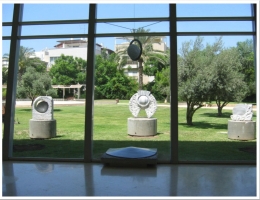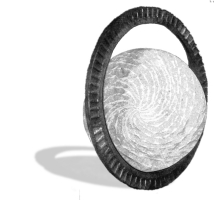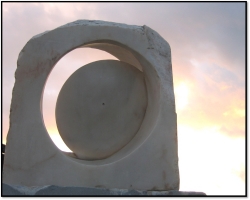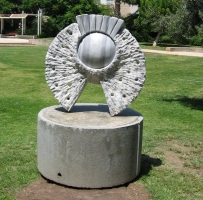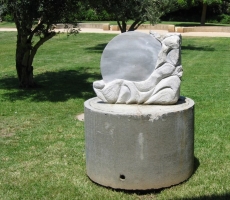The exhibition at the Givatayim Theater is divided into two parts that come together to form one circular, complete unit. One half is located outside, in the gardens of the theater, which is reflected through its large glass wall. The other half can be found in the sculpture corridor connected to the central gallery on the lower floor. Avi Sperber’s exhibition deals with the fate of man inspired by the solar system and is connected to the astrological signs by means of an elaborate installation composed of groups of massive sculptures. Each sculpture deals with a planet that symbolizes certain conventions. In the center, on both sides of the glass, the “Great Conjunction” can be found, which connects Jupiter to Saturn in the sign of Aries – a historical occasion that occurs once every one thousand years and dramatically effects world events.
The circle of sculptures, which include the sun, the moon and the rest of the planets, is overseen by a sculpture of a wheat stalk – sort of a symbol of a human form, where the image of the artist himself can be recognized standing in the medium and moving the system with his creations. Inside the installation the viewer is treated to a unique and dramatic experience based on the mutual relationship with the sculptures and between the sculptures themselves.
This series of sculptures provides a creative summit in Avi Sperber’s continuing research, which combines scientific and astrological aspects, together with an artistic interpretation and natural materials taken from the surrounding landscape. The sculpture of the planet Jupiter presents a round, symmetrical circle chiseled with care on a square notched with rows of lines surrounding it. The sculpture of the Sun was inspired by ancient Indian sculpture and shows a stone circle crowned with 7 divided petals. On the notched circle’s surface, holes have been drilled which provide it with a sense of majesty. The Moon is depicted as a clean and smooth circle breaking out from a hewn stone symbolizing poetry and enlightened purity. Mars is represented as a massive, wide hewn circle incorporating a center of energy, sitting on a powerful base which projects strength. Saturn is portrayed as a flat hewn sphere connected to a metal ring with contours on its exterior. Mercury is represented by two stones hacked from one larger one and creates empathy with the viewer. The planets create a large, dramatic and theatrical installation.
Doron Polack, Curator
